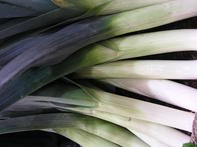Crop Rotation
The leek is a light feeder and requires slightly less nutrition than other crops. Leeks can therefore be planted after most other types of vegetables. Most crops can follow leeks except beans and onions. Yield (tonnes per hectare) Mature full sized leeks with 12 cm to 15 cm white shanks and diameters of 2 cm to 3 cm. Conservative:15 tonnes Average: 25 tonnes Good: 40 tonnes
Harvesting
Harvesting time depends on the size and type of leek that is required for the market. For mature, full-size leeks this will be when the blanched white shanks of the leek are about 150 mm long and have a diameter of between 20 mm and 30 mm.
Tender baby leeks are normally harvested at diameters of 10 mm to 15 mm. Harvesting of large leek farming operations is done by machine.
The modern machines loosen the soil and cut the leek roots just below the white shank and lift leeks from the soil and also top the leek leaves. This can also be done by hand where sufficient labour is available by loosening the soil around the roots with a fork or shovel and pulling the plant free by hand.
After lifting the leeks, the roots are trimmed to about 10 mm and the leeks are washed and packed in crates to be stored in a cool area before sorting and packing for market.